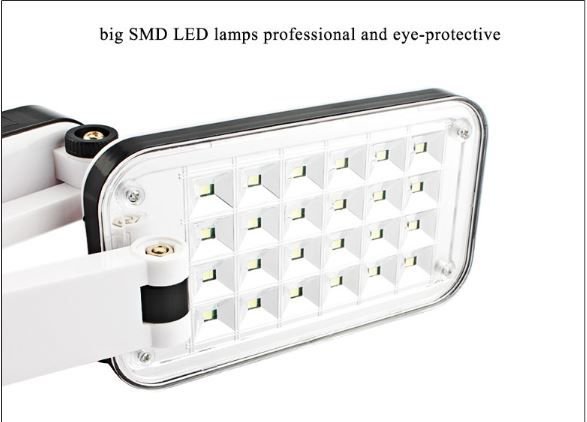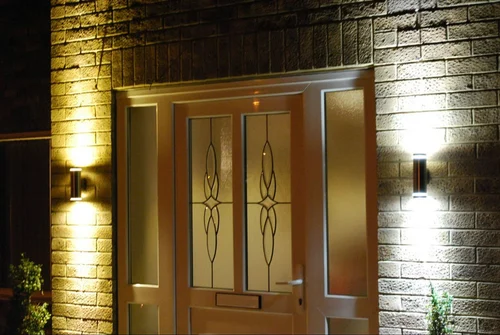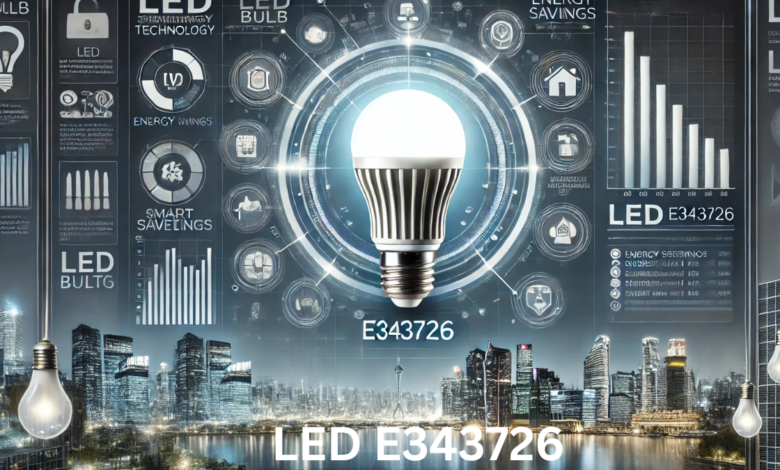LED E343726 is a certification marking available on some LED lights, which is proof that the said product meets standards set forth by UL, ETL, or other authoritative organizations and has suitable Safety and performance levels. Such Certification is critical to achieving quality standards amongst LED products with regard to electrical, mechanical and energy Safety. By learning about these requirements, customers will understand the important features of LED lighting products and establish confidence in their purchase decisions. In the manuscript, we will explain the purpose of regulatory measures for LED certification standards, the details of LED E343726, and some factors that should be in mind when buying certified LEDs.
What is LED E343726?
‘E343726’ E mark is simply an indicator of a positive regulatory test of an LED product or component, which confirms compliance with safety and performance criteria such as those of UL or ETL. In short, it is a unique identifier for an LED product that indicates the product has been qualified to bear certain electric safety measures typically used for household, commercial, or even industrial purposes. Under circumstances where the E343726 code is applicable, then the product has been certified to reception standards, meaning that it is compliant with safety standards and approved for sale.
- Certification Bodies: UL and ETL are two of the widely accepted certification bodies in the field of lighting. Any products with UL or ETL codes have passed a series of stringent testing criteria.
- Standardization: These certifications are mandated with structural criteria that control electrical risks, ensure effective service provision, and extend the life of the LED lights. For example, the UL 8750 is a very well (ch) common standard for LED lighting.
In what ways does Certification Assist Safety and Dependability

Certified LED products are not only more secure but, in addition, more efficient and last longer than uncodified models. Codes such as led E343726 are good examples of standardization that make sure that LEDs are fit for tough working conditions in which performance and reliability can’t be compromised.
| Benefits of Certified LEDs | Description |
|---|---|
| Electrical Safety | Reduces the risk of electrical hazards, such as overheating or short-circuiting, ensuring safer installations in various environments. |
| Energy Efficiency | Certified LEDs generally adhere to energy-efficient designs, translating into reduced electricity consumption and environmental impact. |
| Longer Lifespan | Compliance with durability standards leads to a longer product lifespan, saving replacement costs over time. |
| Quality Assurance | Products with certifications undergo testing for consistent light quality, minimizing issues like flickering or color degradation over time. |
Understanding LED Certification Codes Like E343726
LED certification codes, such as E343726, serve as identifiers tied to the quality and safety compliance of LED products. These codes help trace the product back to its testing records and ensure it meets specific criteria.
- UL (Underwriters Laboratories): A widely recognized testing agency that certifies the electrical safety of various products. UL certifications for LEDs often follow the UL 8750 standard, which applies specifically to light-emitting diode equipment for use in lighting products.
- ETL (Intertek): ETL certification indicates that an LED product has met standards similar to UL and has been tested by an OSHA-approved laboratory, adding credibility to the product’s quality.
For products carrying codes like E343726, these identifiers allow consumers and installers to verify a product’s adherence to safety and performance standards directly through certification bodies’ databases.
How to Verify the Certification of LED Products
When purchasing LED products, verifying the certification can prevent the purchase of counterfeit or low-quality items. Both UL and ETL have public databases where consumers can enter codes like E343726 to confirm the product’s compliance.
Steps to Verify UL Certification
- Visit the UL Product iQ website.
- Enter the product code (e.g., E343726) to retrieve certification details.
- Confirm the listed product matches the one you intend to purchase.
| Certification Body | Verification Method |
|---|---|
| UL | Use the UL Product iQ online database to verify certification codes such as E343726. |
| ETL | Use the Intertek website to confirm certification codes, ensuring the product meets the necessary standards. |
Comparing Certified and Non-Certified LEDs: Performance Metrics and Longevity
Certified LEDs, which have markings like E343726, are designed using the best standards and, hence, are more reliable, effective and safe. On the contrary, Non-certified LEDs do not conform to such stringent requirements and specifications and are, therefore, likely to perform poorly and fail more easily.
| Performance Metric | Certified LEDs (e.g., E343726) | Non-Certified LEDs |
|---|---|---|
| Lifespan | 25,000+ hours, with consistent performance over time | Often shorter lifespan, less consistency |
| Safety | Tested to prevent hazards like overheating or electrical shocks | May not comply with safety regulations |
| Energy Efficiency | Typically more efficient, reducing energy costs | May consume more power, reducing efficiency |
| Color Quality and Stability | Maintains color and brightness over time | Prone to flickering or color degradation |
Important Things to Keep in Mind When Buying Certified LED Products

When purchasing LED lights, in particular, those certified, i.e., E343726, some factors focus on performance and durability, among others that are important to your purchasing needs.
Wattage and Luminous Efficacy
It is common that certified LEDs have a higher luminous efficacy, meaning they give out more light. Hence, it is important to purchase the right wattage lumens so that the amount of brightness required is reached without wastage of energy.
Color Temperature and CRI (Color Rendering Index)
Most certified LEDs cite where it indicates the light’s color, which is measured in degrees Celsius, called the color temperature, and the CRI, which is a measurement standard detailing what spectrum is accurate under a light. For instance, within a domestic environment, it is more useful to have a warm light color of about 2700K- 3000K. However, in commercial spaces where productivity and visibility are important, brighter assortments ranging from 4000 K to 5000 K are used.
Heat Dissipation
Dissipating heat sufficiently is essential for LEDs to achieve their designed Lifespan. Certified LED lights are made of materials and design features that ensure proper heat dissipation and prevent heat-related failures that occur in un-certified or lower-grade LEDs.
Compatibility with Dimmers and Smart Controls
Most modern certified LEDs are also compatible with dimming switches and smart light systems. As a result, users can easily change light levels, save power, and incorporate these LEDs into smart systems.
Environmental and Health Compliance
Certified LEDs E343726 and others project a good image in the environmental sphere while being ecologically sound. Such LEDs are often compliant with RoHS (Restriction of Hazardous Substances) directives, which means they do not contain harmful substances like mercury at all. This feature is very helpful in indoor applications since it enhances the Safety of homes and places of work.
| Factor | Description |
|---|---|
| Wattage and Luminous Efficacy | Ensures energy-efficient light output without excess power usage. |
| Color Temperature and CRI | Determines light quality, color accuracy, and suitable applications. |
| Heat Dissipation | Prevents overheating, extends product lifespan. |
| Compatibility | Works with dimmers and smart controls, offering flexibility and energy-saving options. |
| Environmental Compliance | Certified to be free from hazardous materials, promoting safer usage in residential spaces. |
Energy Savings and Environmental Impact of Certified LEDs
What is more, choosing products with CertificationLED certifications also has benefits for the environment. Led certified is designed to use fewer resources, which can include fuel, reduce gas emissions and reduce electronic wastage. Led designs encompass advanced technology that can lower electrical consumption by 85% compared to incandescent bulbs. Moreover, the lifetime of the certified LEDs is longer, which minimizes the need for a replacement and, hence, less waste to the environment.
- Wasteful Energy Use Illustration: The certified LEDs utilize chip technology, which lowers the power used with increased brightness to a standard level, which then leads to overall reductions in high power use.
- Great reduction of the carbon footprint with energy saving measures: Certified LEDs consume less energy, which in turn reduces the emissions, bringing forward sustainable living solutions.
- Incessant production and indiscriminate disposal of consumer products have been largely responsible for sight and environmental pollution. With certified LEDs, such products which credentialed are longer lasting than other standard LED models, thus reducing the probability of disposal into landfills.
- As estimated by the U.S. Department of Energy: If LED lighting is adopted across the globe, the world can conserve more than 348 TWh of electricity by the year 2027; this is almost equivalent to the generation of 44 large-scale electricity power plants.
Examining the LED Market: Trends and Innovations in the LED Industry
Over the past few years, the LED sector has witnessed rapid growth as the focus shifts towards greener solutions, advanced technology integration and improved color quality. With consumers becoming more aware of energy usage and its effects, LED products that are industry-certified are dominating the market.
Trends in LED Technology
- Smart LED Lights: Today, a number of certified LEDs enable control using mobile apps, voice commands and automation.
- Color Tiltable LEDs: These LEDs also enable users to alter the color temperature from warmer to cooler depending on the environment it has to work with or the nature of the work to render.
- MicroLEDs and OLEDs convolution: These new LED types are high-resolution, conformable LEDs for the commercial and consumer markets.
- Improved standards of energy efficiency: New Certification improves and sets the benchmark for energy efficiency, thus allowing the LED industry to move towards more environmentally friendly products.
Such innovations highlight the relevance of obtaining certificates like E343726 since, as the technologies improve, compliance and Certification will remain a necessity.
Also Read More: kääbntäjä
All You Need to Know When Choosing the Right Certified LED for Your Needs

When purchasing certified LEDs, it is important to consider the product specifications in relation to the task. Below are some factors to consider for various uses:
Domestic Application
For domestic premises, a comfortable atmosphere can creat using certified warm white LEDs (2700K-3000K) and offering long hours of energy saving, such as certified dimmable ones. Moreover, energy-efficient certified LEDs assist in reducing utility expenses.
Commercial Application
For the majority of office spaces, retail spaces or workplaces where visibility is a concern, certified higher color temperature (4000K-5000K cool white) with better luminous efficacy LEDs would be ideal. Led commercial fixtures are said to design with added toughness and a better life span.
Outdoor and industrial applications
Communal and industrial sites require certified LED lamps to be weatherproof and dustproof with higher IP (Ingress Protection) ratings. These environments also add the benefit of cool roof-integrated LEDs that are highly certified for Safety and have superior thermal management.
Smart Home Integration
They also aim to give users a brilliant smart home experience with features such as smart scheduling/commercial integration and remote control via smartphone apps or voice. This is another way of improving users’ experience together with energy efficiency.
You would enhance your lighting arrangement, achieve every aspect of its aim through performance and security, and effectuate efficiency by recognizing your particular requirements and checking certified figures like LED E343726.
FAQs About LED E343726 and Certification Codes
To shed more light on certified LED products, we will now respond to some of the frequently asked questions regarding LED E343726 and other codes of Certification.
What is the meaning of LED E343726?
LED E343726 is a very common certification mark that indicates that LED lighting products are safe and of good quality. This means that an accredited body (UL, Intertek, etc.) has approved the product for safe and efficient operation in environments where electrical Safety is a prime requirement.
What is the necessity of spending on certified LEDs?
When buying LEDs, one always knows what to expect concerning quality and performance, for they are sure to be certified. The Certification implies that the product has adequately test for electrical Safety, energy efficiency, heat dissipation, and reliability, therefore mitigating the risks that one would expose oneself to when dealing with untest products, such as overheating or underperformance.
In what ways do certified LEDs assist in reducing energy costs?
Certified LEDs operate with the use much less energy than conventional options, for example, incandescent or fluorescent lights, with energy spending being reduce by as much as 85 percent. This is because modern technology designs have high light output with low wattage.
Do certified LEDs help in conserving the environment?
Yes, certified OH LED lights are environmentally friendly because they use fewer resources, work longer periods, and even meet certain standards. In addition, a lot of certified LEDs do not contain toxic materials like mercury, which makes their disposal safe at the end of their useful life.
What is the normal life expectancy for certain certified LEDs, such as the LED E343726?
LED’s Certification gives them that extra qualification. Still, even incandescent bulbs have an average life expectancy of 15,000 to 50,000 hours which expect to even longer depending on use & type. Some certified LEDs also provide warranties that use these bulbs for some years, thus encouraging them to use these bulbs.
Will I be able to use certified LEDs with dimmers and smart systems?
Numerous certified LEDs utilize with dimmer switches and can engage in automat smart home systems. However, it is essential to review product specifications for specific certified LED models that include these features because not all of these models do.
The Future of LED Certifications and Consumer Trends
With advancements in LED technology, it expect that new certification standards and practices will emerge, including considerations for smart lighting, more robust energy efficiency, and higher levels of strength and durability. This practice will encourag by the growing interest of consumers in quality and environmentally sound lighting. With regulations becoming more stringent, users will aide in making more responsible choices through codes such as E343726.
Conclusion
LED Certification such as E343726 assists consumers in making educated decisions regarding the Safety, quality, and functionality of LED products. Such users also know that the products they purchase test for efficiency, electrical Safety, and serviceability because they meet established standards. Making inform purchasing decisions would not possible without logos denoting Certification, as these mark an assurance that certain standards of quality to which less reputable items may not conform pass. As the world of LEDs continues to expand, it is imperative that consumers understand what these certifications mean so they can make well-informed choices regarding the lighting products that they are looking for and ensure their Safety and effectiveness.
Also Read More: Speedyshort

